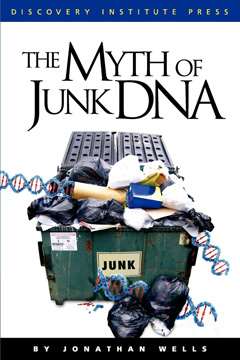
At Genome Biology and Evolution, a paper identifying uses for “junk DNA” (non-coding DNA), using the flatworm as an illustration:
The days of “junk DNA” are over. When the senior authors of this article studied genetics at their respective universities, the common doctrine was that the nonprotein coding part of eukaryotic genomes consists of interspersed, “useless” sequences, often organized in repetitive elements such as satDNA. The latter might have accumulated during evolution, for example, as a consequence of gene duplication events to separate and individualize gene function (Britten and Kohne 1968; Comings 1972; Ohno 1999). This view has fundamentally changed (Biscotti, Canapa, et al. 2015), and our study is the first one addressing this issue with structural, functional, and evolutionary aspects for the genome of a multicellular parasite.
Maria Stitz, Cristian Chaparro, Zhigang Lu, V Janett Olzog, Christina E Weinberg, Jochen Blom, Alexander Goesmann, Christoph Grunau, Christoph G Grevelding, Satellite-Like W-Elements: Repetitive, Transcribed, and Putative Mobile Genetic Factors with Potential Roles for Biology and Evolution of Schistosoma mansoni, Genome Biology and Evolution, Volume 13, Issue 10, October 2021, evab204, https://doi.org/10.1093/gbe/evab204
This is the type of species they were studying:
Plus a supportive editorial that doesn’t just dismiss this find as an outlier but addresses the assumptions behind “junk DNA” directly:
“The days of ‘junk DNA’ are over,” according to Christoph Grunau and Christoph Grevelding, the senior authors of a new research article in Genome Biology and Evolution. Their study provides an in-depth look at an enigmatic superfamily of repetitive DNA sequences known as W elements in the genome of the human parasite Schistosoma mansoni (Stitz et al. 2021). Titled “Satellite-like W elements: repetitive, transcribed, and putative mobile genetic factors with potential roles for biology and evolution of Schistosoma mansoni,” the analysis reveals structural, functional, and evolutionary aspects of these elements and shows that, far from being “junk,” they may exert an enduring influence on the biology of S. mansoni.
Casey McGrath, Highlight— “Junk DNA” No More: Repetitive Elements as Vital Sources of Flatworm Variation, Genome Biology and Evolution, Volume 13, Issue 10, October 2021, evab217, https://doi.org/10.1093/gbe/evab217
Both papers, linked above, are open access.
So the house is clearly supporting this move away from the Darwinian position. Oh yes, let’s not forget that “junk DNA” was very much a Darwinian position.
For example, see Francis Collins in The Language of God. (2007):
Darwin’s theory predicts that mutations that do not affect function, (namely, those located in “junk DNA” ) will accumulate steadily over time. Mutations in the coding region of genes, however, are expected to be observed less frequently, and only a rare such event will provide a selective advantage and be retained during the evolutionary process.” That is exactly what is observed.” (pp. 129-30)
For more on that, see: “Francis Collins, Junk DNA, God, And Whatever”

Most or all of the Darwinian Bigs signed onto junk DNA as part of their thesis about the unguided nature of life. See:
In 1980, two papers appeared back to back in the journal Nature: “Selfish genes, the phenotype paradigm and genome evolution,” by W. Ford Doolittle and Carmen Sapienza, and “Selfish DNA: The ultimate parasite,” by Leslie Orgel and Francis Crick. The first paper argued that many organisms contain “DNAs whose only ‘function’ is survival within genomes,” and that “the search for other explanations may prove, if not intellectually sterile, ultimately futile.” [1]
The second argued similarly that “much DNA in higher organisms is little better than junk,” and its accumulation in the course of evolution “can be compared to the spread of a not-too-harmful parasite within it host.” Since it is unlikely that such DNA has a function, Orgel and Crick concluded, “it would be folly in such cases to hunt obsessively for one.”[2]
[1] Nature 284 (1980): 601-603.
[2] Nature 284 (1980): 604-607.
Jonathan Wells, The Myth of Junk DNA, (2011), p. 20.
The big question will doubtless be put off for now: Why does it only count if Darwinian predictions are right but never if they are wrong?
Oh, by the way, what about Dan Graur, the pro-junk DNA advocate who wasn’t going to “do politeness” on the topic any more?
I have no idea where @GrunauChristoph & Christoph Grevelding studied genetics, but to make grand pronouncements on junk DNA and equate junk DNA with non-coding & repetitive sequences is wrong factually & historically. They should ask for a tuition refund. https://t.co/YnS9qeCih2 pic.twitter.com/YgOiuA3qoT
— Dan Graur (@DanGraur) October 5, 2021
and
The fact that these outrageous, fanciful, and baseless interpretations were published @GenomeBiolEvol is a crime against historical accuracy. I expect such ignorant claims from medical journals or #BigData pseudoscience journals, but not from a journal published by @OfficialSMBE.
— Dan Graur (@DanGraur) October 5, 2021
Dan, politeness just makes life easier. That’s all.
See also: At Evolution News and Science Today: The Appalling Moral Failure of Francis Collins. John G. West: The disclosures about the experiments followed Collins’s repeal earlier this year of restrictions on the use of aborted fetal tissue in NIH-funded research… researchers also sliced off skin from the scalp of the aborted babies and then grafted the fetal skin onto the mice. In the words of the scientists: “Full-thickness human fetal skin was processed via removal of excess fat tissues attached to the subcutaneous layer of the skin, then engrafted over the rib cage, where the mouse skin was previously excised.” The body parts used for these experiments were harvested from aborted human fetuses with a gestational age of 18-20 weeks. By that age, an unborn baby has brain waves and a beating heart. He can hear sounds and move his limbs and eyes …